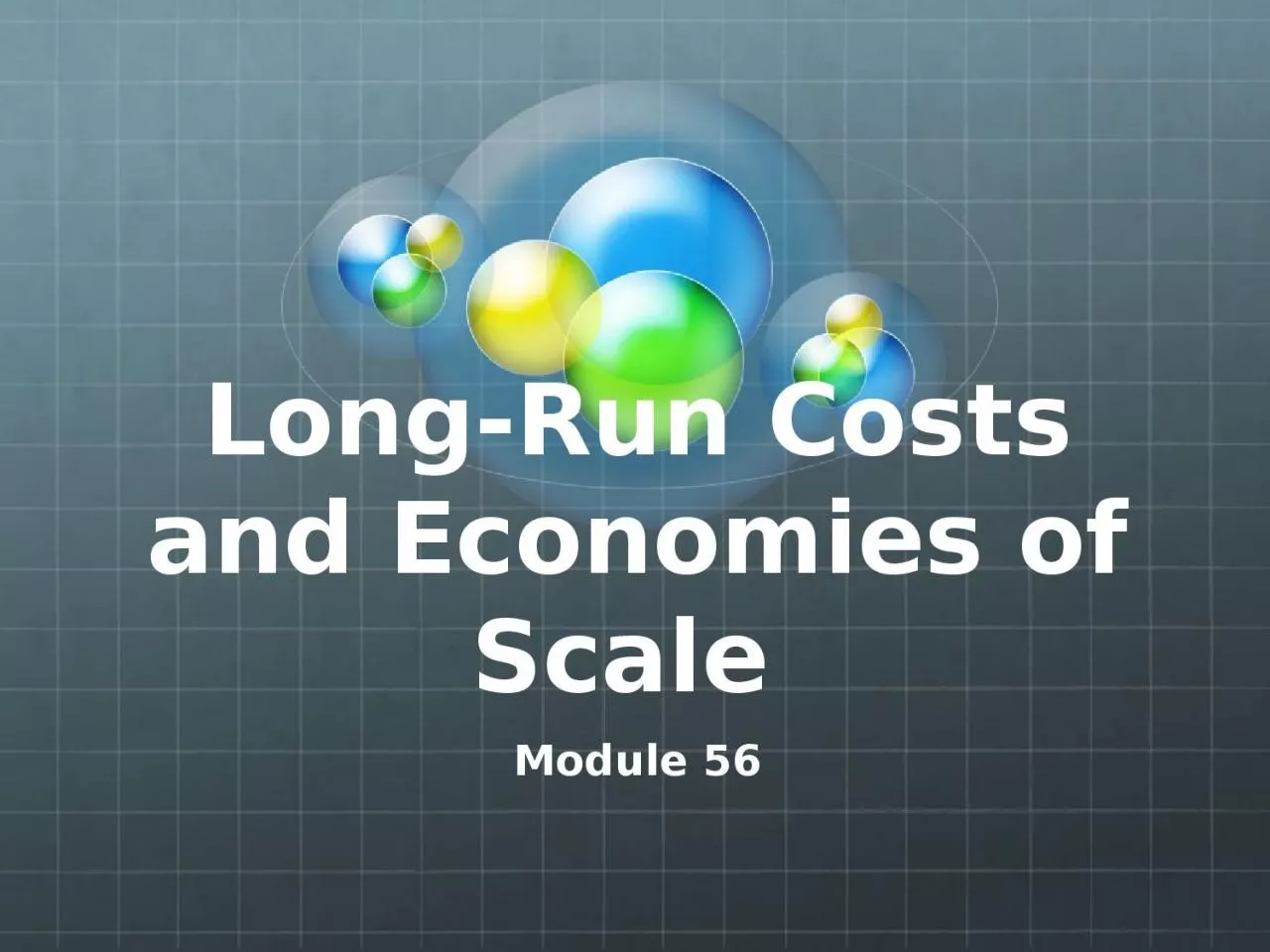

Module 56 Behind the Supply Curve Behind the Supply Curve Costs and the Long Run Firms short run fixed cost is variable IN THE LONG RUN Way to frame it The ShortRun is a snapshot of a firms day ID: 1029077
Download Presentation The PPT/PDF document "Long-Run Costs and Economies of Scale" is the property of its rightful owner. Permission is granted to download and print the materials on this web site for personal, non-commercial use only, and to display it on your personal computer provided you do not modify the materials and that you retain all copyright notices contained in the materials. By downloading content from our website, you accept the terms of this agreement.
1. Long-Run Costs and Economies of Scale Module 56
2. Behind the Supply Curve
3. Behind the Supply CurveCosts and the Long RunFirm’s short run fixed cost is variable IN THE LONG RUNWay to frame itThe Short-Run is a snapshot of a firm’s dayThe Long-Run is a series of snapshots turned into a video
4. Behind the Supply CurveIn the Long-Run, firms can choose the appropriate fixed costs for outputFor example:Firms can choose to buy a variety of new equipmentLowers its ATC in the LONG-RUNBy buying new machinery, fixed costs go UP but variable costs drop considerably
5. Firms adjust Upwards (Expansion) or Downwards (Contraction) in the Long RunExamples:McDonald’s franchise opensLocal restaurant adds a new dining roomChrysler closes a factory in Twinsburg, OhioBrowns build a brand new stadiumA pizza franchise closes down
6.
7. Behind the Supply CurveNeed to add time to the discussion of costs and the firmThis means…All the ATC curves we have discussed are based on FIXED costsTherefore...There are many possibilities of fixed costs (short run) for a firm (“family” of SRC curves)
8. Behind the Supply CurveLong-Run Average Total Cost (LRATC)Based on output, LRATC is the relationship between output and average total cost, WHEN a fixed cost has been choseChose a fixed cost?Rent, Machinery, etcDifferent combination of fixed costs
9. Behind the Supply CurveEconomies of ScaleScale – the size of a firm’s operations Scale effects – Long-Run ATC change dramatically if quantity of output is changedIncreasing returns to scale When output increases proportionally more than inputsEx: SalsaLeads to decreasing LRATC
10. Behind the Supply CurveDiseconomies of ScaleWhen LRATC increases as output increasesDecreasing returns to scale
11.
12. How could a firm enjoy economies of scale?Specialization of laborHigh startup costsBulk buying of inputs
13. How could a firm suffer from dis-economies of scale?InefficienciesLack of coordinationLack of communicationSize (limits?)
14. Internal Economies of ScaleThese are economies made within a firm as a result of mass production. As the firm produces more and more goods, so average cost begin to fall because of:Technical economies made in the actual production of the good. For example, large firms can use expensive machinery, intensively. Managerial economies made in the administration of a large firm by splitting up management jobs and employing specialist accountants, salesmen, etc. Financial economies made by borrowing money at lower rates of interest than smaller firms. Marketing economies made by spreading the high cost of advertising on television and in national newspapers, across a large level of output. Commercial economies made when buying supplies in bulk and therefore gaining a larger discount. Research and development economies made when developing new and better products. External Economies of ScaleThese are economies made outside the firm as a result of its location and occur when:A local skilled labor force is available. Specialist local back-up forms can supply parts or services. An area has a good transport network. An area has an excellent reputation for producing a particular good. Sheffield is associated with steel.
15. Internal Diseconomies of ScaleThese occur when the firm has become too large and inefficient. As the firm increases production, eventually average costs begin to rise because:The disadvantages of the division of labor take effect Management becomes out of touch with the shop floor and some machinery becomes over-manned. Decisions are not taken quickly and there is too much form filling. Lack of communication in a large firm means than management tasks sometimes get done twice. Poor labor relations may develop in large companies. External Diseconomies of ScaleThese occur when too many firms have located in one area. Unit costs begin to rise because:Local labor becomes scarce and firms now have to offer higher wages to attract new workers. Land and factories become scarce and rents begin to rise. Local roads become congested and so transport costs begin to rise.
16. Behind the Supply CurveSunk CostsCost that has already been incurred, and is NON-RECOVERABLESunk costs should be ignored in a decision about future actionsPsychologically difficult to ignore sunk costs
17. Sunk Cost ExamplesStaff Training and EducationProduct ResearchAdvertisingSpecialty EquipmentConsultants